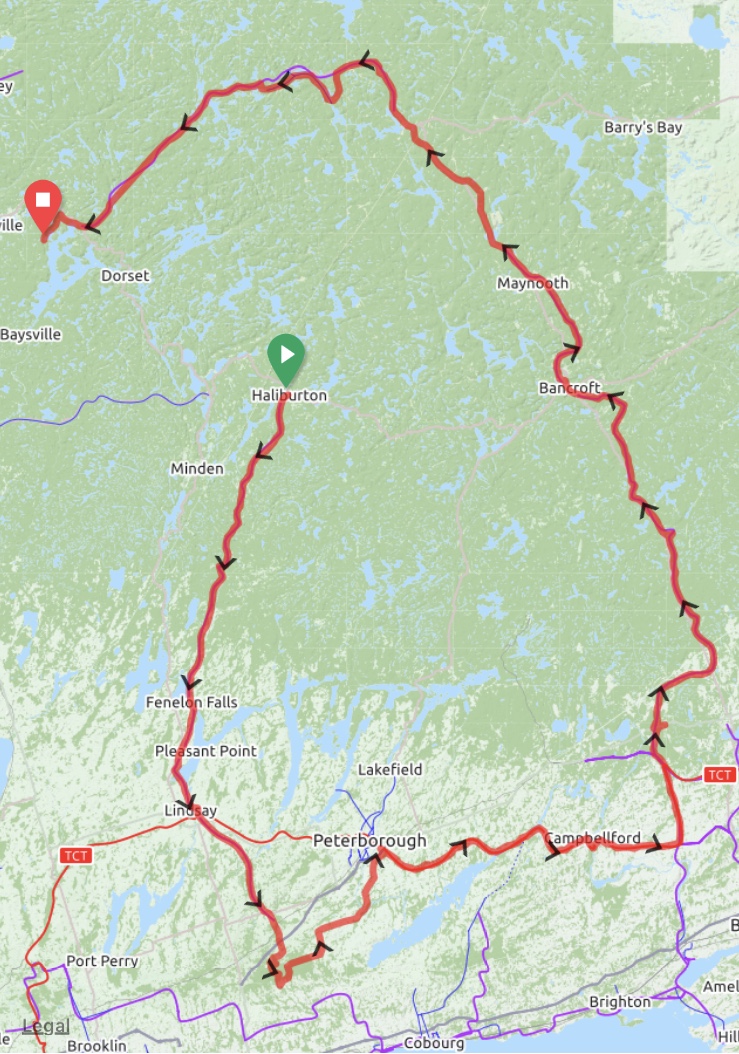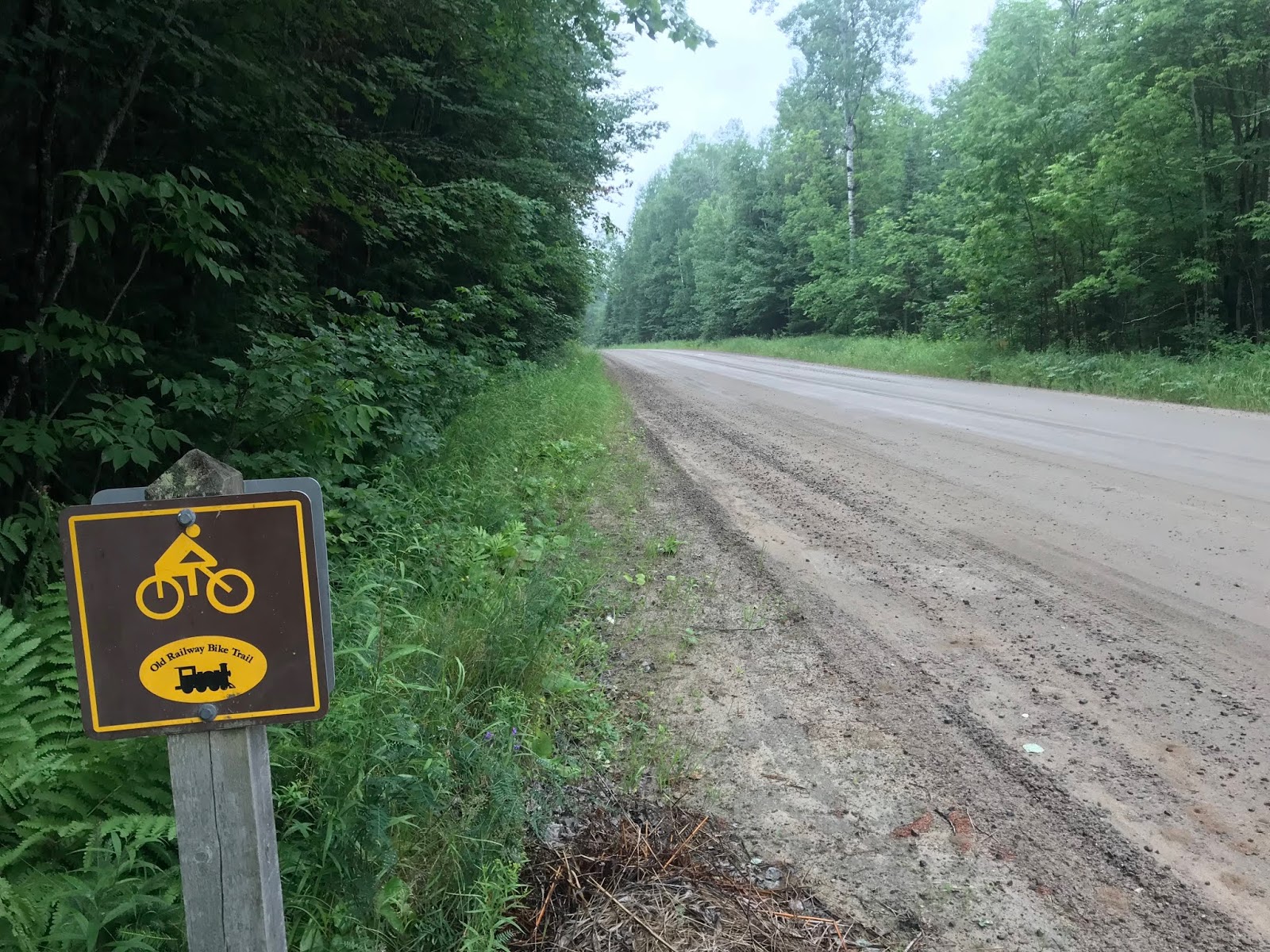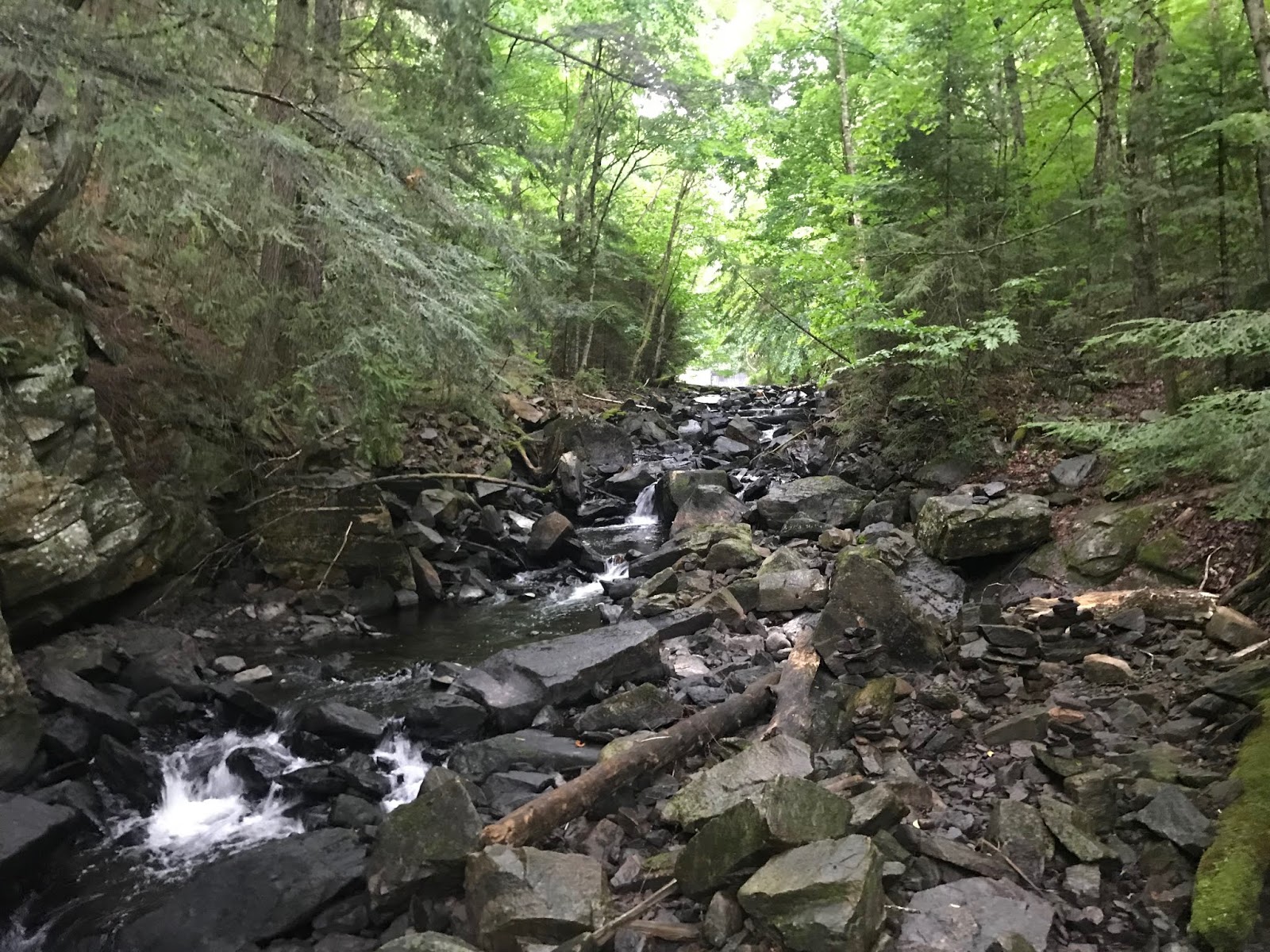 |
| Haliburton to Lake of Bays, the long way around. |
When I learned I'd have the chance to visit family in Central Ontario over the summer, I got inspired by a route posted by Miles Arbour on bikepacking.com that I had wanted to explore. Desirous of bigger mileage and plenty of single track, I modified the route to suit my needs - traveling east from the Ganaraska Forest to the town of Milbrook, crossing beneath Peterborough avoiding heavily congested areas closer to Lake Ontario, extending the route further north through Algonquin Park. The logistics of overhauling and transporting my bike up to Canada were not simple, and I'm lucky to have a family that works hard to enable my pastime. I was offered a lift to Haliburton so I could start the journey on rail trail instead of with a whole day of highway riding. Thanks, Mom and Dad for everything you did to help.
 |
Day 1: Haliburton to Lindsay.
I was a little too excited to get started and neglected to fill my water bottles before rolling out of Haliburton. Within twenty miles I dropped a glove on the side of the trail and spent a half hour in a futile search through the weeds. Gloveless and dehydrated, yet undeterred I pressed on. After finding water in Kinmount, I learned about a disastrous failed settlement of Icelandic immigrants who in 1874 came to the area to work on the railroads. Arriving too late in the autumn to plant crops, and housed in poorly ventilated, unsanitary conditions, they died in large numbers and eventually relocated to Manitoba. A stone memorial marks the site near a lumber mill on the Burnt River in Kinmount. I made good time to Lindsay where five dollars secured a campsite at the Trent-Severn waterway locks.
 |
| The Trent-Severn Waterway locks in Lindsay. |
 |
| Satellite view of the locks |
Day 2: Lindsay to Milbrook via Ganaraska Forest. 65 miles
I rode south from Lindsay on the Victoria Rail Trail to Dranoel where spectacular dirt roads lead to the Ganaraska Forest, a beautiful park with over 100 km of mountain bike trails.
 |
| Neat trestle bridge |
 |
| Minimum maintenance roads on approach to Ganaraska Forest |
I made up the route through the trees as I went along, there were just so many trails. I oriented myself roughly south and east toward the Ganaraska Forest Centre. There are ATV/motocross trails, hiking, horseback riding, and treetop ropes courses here as well. After wearing myself out riding single track, I arrived at the deserted Forest Centre and finding the bathrooms unlocked I grabbed a shower and rested a bit before deciding to move on and get a proper dinner. I rode north and east to the town of Milbrook where I ate at Moody’s restaurant, then made camp in a small park. Milbrook has a bike shop and bakery-cafe (Frog Cycles, and the Pastry Peddler) but by morning I was ready to move on before they opened, so I’ll return and pay a visit some day.
Day 3: Milbrook to Marmora.
Just before crossing the Ranney Gorge Suspension Bridge, my bike toppled over while I was taking photos. Luckily it didn’t fall all the way into the gorge, and while there was no obvious damage, I noticed the dynamo hub wasn’t powering the headlight nor would it charge my phone or power banks. I plugged a battery into the light and it still worked, so there must have been a break or a short in the wiring. I had been living high on the power hog, taking loads of photos and videos, instagramming and tweeting, and listening to music. I had assumed unlimited power, but now my phone was at 20% and my backup batteries were low. I made for the Marmora KOA campground, and on the way had dinner at an odd but very nice restaurant attached to a paintballing course and biker meetup spot. I made it to the KOA just as they closed the office, but failed to plug in any battery packs to charge overnight.
 |
| Vast wetlands stretch across the horizon |
Day 4: Marmora to Bancroft.
I spent several hours in the morning attempting to repair the damaged wiring of my dynamo system, with no success. It's not exactly rocket surgery, but I'm slightly inept when it comes to electrics, so I didn't leave the campground until past noon.
Much of the day was on long, rutted sections of rocky, sandy trail. Even with big tires, trying to maintain any speed on the rigid frame bike was a bone-jarring ride. Reduced to a crawl, I was an easy lunch for swarms of biting flies and mosquitoes. Slogging along, breathing the dust kicked up by ATV's and motorbikes was starting to get old. I felt pretty beat up after hours of slow progress. Salvation arrived in the form of a double bacon cheeseburger at Big Al's Burger Stand which miraculously materialized out of the woods, the only place around for miles. I helped myself to the pickle juice in the condiment tray. I grabbed some bomb ass butter tarts and juice at a gas station, and not even being heckled by local teens could diminish that glorious moment.
 |
| The Big Al |
Signage along the trail to Bancroft promised a hotel with wifi and a hot tub, but arrival in town revealed a family reunion booked out every hotel and campsite in town. I found a stealthy spot to camp near a park with bathrooms, water, and cruicially, a covered shelter with power outlets where I left a battery pack to charge overnight.
Day 5: Bancroft to Lake of Bays via Algonquin Park.
Algonquin Park is a huge park and has loads of things to do, though not as many mountain bike trails as the Ganaraska Forest. The weather had been perfect up until now, but the rain finally arrived. I got out my rain jacket, but for some reason didn't bother with shoe covers. My feet were soaked before I knew it. Tired, wet, and eager for a shower and a bed, I decided to ride on through the park rather than camp another night. Highway 60 was under construction in the eastern portion of the park, so I detoured south to a trail that would cut off a few miles of highway riding.
Algonquin park is lush, pristine, and filled with wildlife. I saw a family of beavers who allowed me to film them for some time. A skunk briefly ran towards me on the trail before darting into the trees. Cardinals, Blue Jays, Egrets, and other birds were everywhere, and deer are everywhere.
 |
| An Egret takes flight |
The air in the park tasted fresh. Aside from my wet shoes and aching body, everything felt perfect, but I was determined to finish the ride before the rains returned. After portaging the bike through a tight, but beautiful hiking trail, I emerged back onto Highway 60, and put the hammer down for the final forty miles. Just as I exited the park I saw large black bear lope across the road ahead of me. Some vehicles drove by and he was gone into the trees, and I was grateful to have met a bear, but at a distance. It was dark by the time I rolled in, but I had just enough battery power left to light up the pitch black back roads of the final miles.
 |
| Some hike-a-bike in Algonquin Park |
I would love to spend a weekend riding all the trails in the Ganaraska Forest, and maybe explore the hiking and ropes courses too. Algonquin Forest is massive and I saw only a small part of it. It would be relatively easy to modify this route to encompass as much rail-trail or single track as you want. Wide tires cruised easily over the gravel highway shoulders, while in other sections the paved shoulder was very wide and felt quite safe. I wouldn't want less than a 2.2" tire for this trip. While certain sections of trail would be fine on a cross, gravel, or touring bike, the sandy, rutted sections, as well as the single track basically requires a MTB for maximum enjoyment. I was very happy with my bike setup and wouldn't change much on a return visit. This was an accessible yet challenging solo ride, and a great re-entry into off-road bike packing. I'm very happy having re-discovered confidence in my abilities, gear, and planning. I can't wait to do some bigger trips in the future.
I want to acknowledge the contributions of my family and friends who made this trip possible. Mom and Dad offered to drive the bike up to Canada, and facilitated the mechanical work beforehand. Luke, Hunter, Karl, and everyone else at Perennial Cycle who overhauled and dialed in the bike so incredibly well. Everything worked better than I could have imagined. Special hat-tip to Karl for all his work, especially the custom handlebar mount for the headlight. The lone mechanical issue I suffered (the severed dynamo wiring) was completely my own fault. Big thank you to Andrew and all my colleagues at NYC Velo for digging deep and allowing me to take time away from work. Everyone else who offered support, you know who you are, and you have my gratitude.
 |
| Big miles, big smiles. |
Bike and gear
The frame is a 2010 Surly Karate Monkey, size XL. Drivetrain is a SRAM NX crank with 32t chainring, and Shimano Deore rear derailleur shifting over an 11-42 tooth cassette with the assistance of a Wolftooth Components Goatlink adapter. This gear range was sufficient for riding single track on the loaded bike but I may switch to a 30t ring for even lower gears. This article was helpful in conceiving and realizing this setup.
The wheels have Velocity Dually rims laced to a SRAM X9 rear hub (a good quality but very low engagement freehub, fine for gravel grinding but not ideal on techy trails), and a Schmidt SON dynamo hub powering the brilliant Sinewave Beacon headlight with USB charger. The Beacon headlight can also be powered by an external battery pack, a feature which came in handy after the hub wiring was severed. Maxxis Chronicle 29 x 3.0" tire up front, and Surly Extra Terrestrial 29 x 2.5” tire out back, both set up tubeless with Orange Seal Endurance sealant. Surly Moloko handlebar, ESI Chunky silicone grips, WTB Pure V saddle, and issi Stomp XL pedals were okay I guess. Avid levers and BB7 brakes just slow you down.
The frame bags are mostly Revelate Designs, with a mix of Banjo Brothers, Lezyne, Jandd, and Surly bags. I carried my tent and extra clothing in a dry bag strapped to the handlebar harness. Rain gear went in the harness front pocket. My food and snacks lived in the gas tank bag and two feedbags. Tools and repair kit in the top tube bag. Batteries and chargers in the Surly Moloko Adjunct handlebar bag, my phone and other cables in the Banjo Bros stem bag. Stove, fuel, cook kit, tent stakes, pump, lock, and other spare consumables in Revelate Tangle frame bag. Sleeping bag and pad were crammed into the Revelate Viscacha seat pack. Two 24oz water bottles in Salsa stainless cages (I would choose side-entry cages next time), and a 40oz stainless canteen is mounted under the downtube with a Velo Orange Mojave cage bolted to a Zefal bottle cage adapter.


















